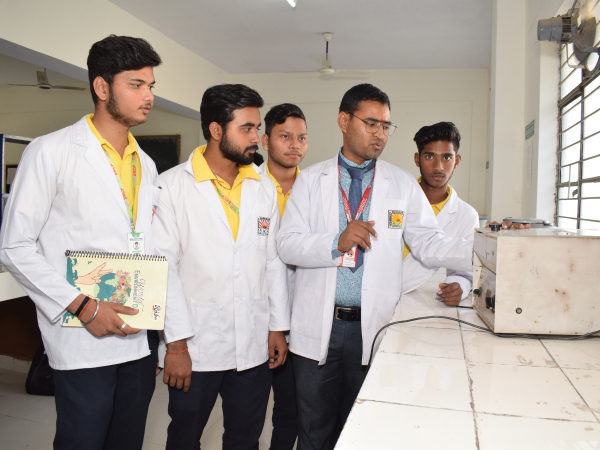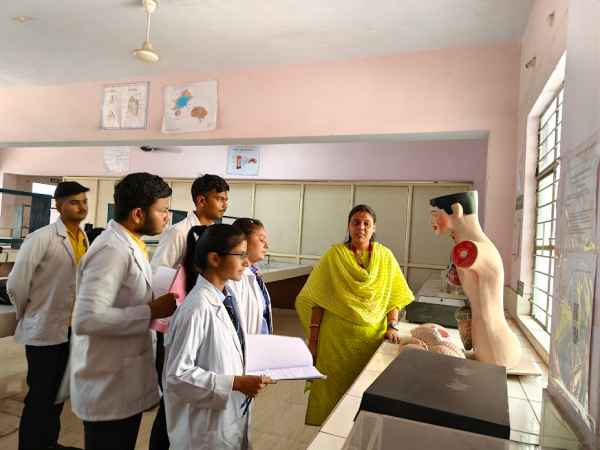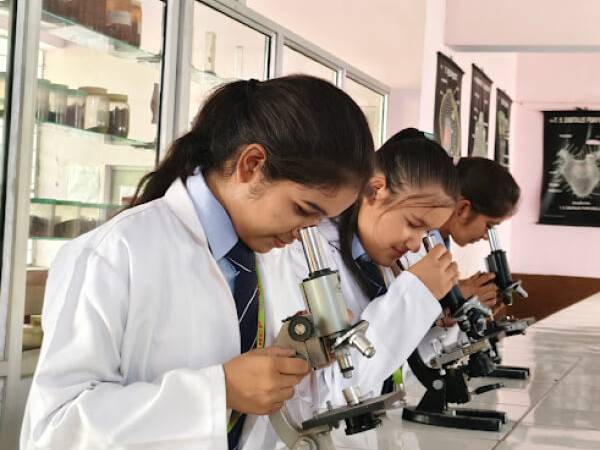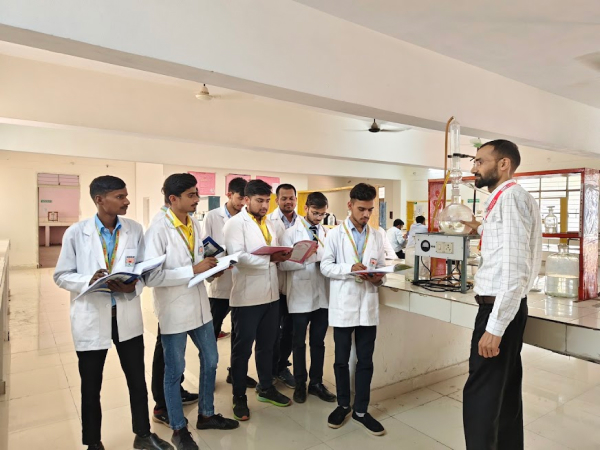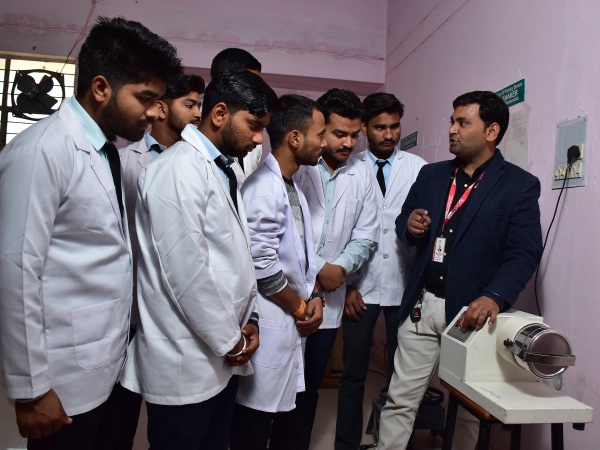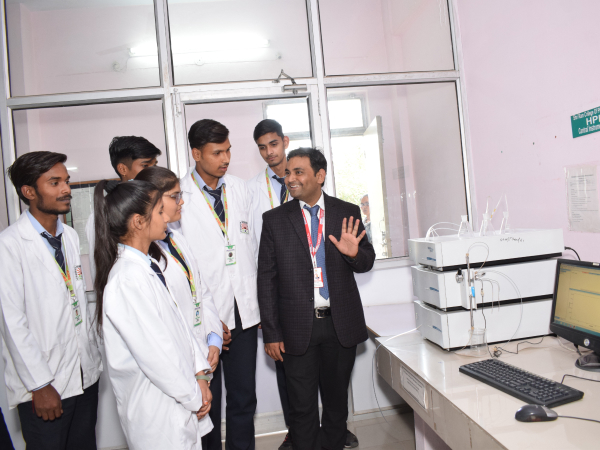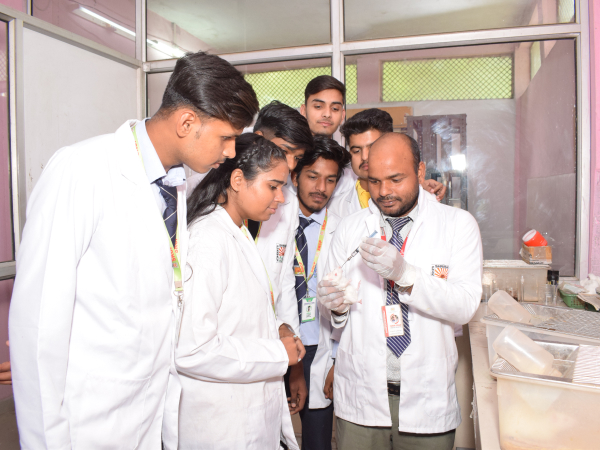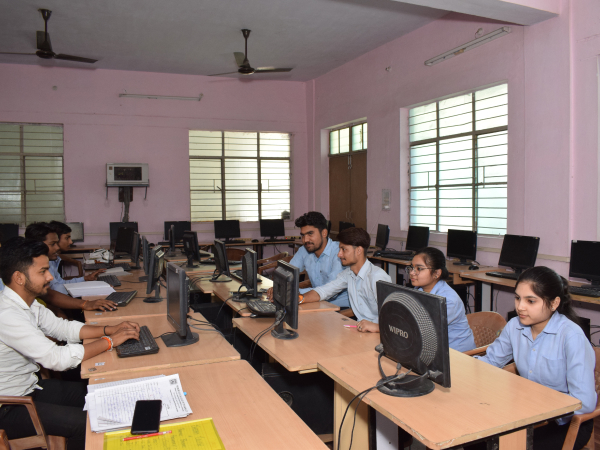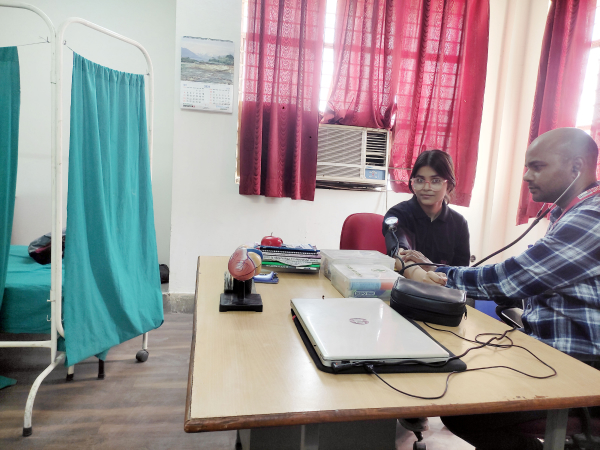LABORATORY
(1) PHARMACEUTICS
Exploring the Realm of Pharmaceutics: A Glimpse into Our Laboratory
- Introduction: Welcome to our Pharmaceutics Laboratory, where science meets innovation to pave the way for groundbreaking pharmaceutical discoveries. Our laboratory serves as the nucleus of research and development, where a diverse team of scientists, researchers, and technicians collaborates to advance the field of pharmaceutical science.
- Mission: At our laboratory, our mission is clear: to pioneer the development of safe, effective, and innovative pharmaceutical formulations. We strive to address unmet medical needs, enhance drug delivery systems, and optimize therapeutic outcomes for patients worldwide.
Facilities: Equipped with state-of-the-art instrumentation and cutting-edge technology, our laboratory provides a dynamic environment for scientific exploration and experimentation. Our facilities include:
- Analytical Instruments: High-performance liquid chromatography (HPLC), spectrophotometers, and other analytical tools enable precise characterization and quantification of pharmaceutical compounds.
- Formulation Lab: Here, scientists meticulously design and develop novel drug formulations, including tablets, capsules, suspensions, and more. We employ advanced techniques such as nanoencapsulation and microemulsion to enhance drug solubility, stability, and bioavailability.
- Biopharmaceutics Lab: This section focuses on studying the relationship between drug properties and biological performance. Through in vitro and in vivo experiments, we assess factors influencing drug absorption, distribution, metabolism, and excretion.
- Quality Control Lab: Ensuring the safety, purity, and potency of pharmaceutical products is paramount. Our quality control lab conducts rigorous testing to meet regulatory standards and uphold product integrity.
Research Areas: Our laboratory is engaged in a diverse array of research areas, including but not limited to:
- Novel Drug Delivery Systems: Developing innovative drug delivery platforms such as liposomes, nanoparticles, and transdermal patches to optimize drug targeting and release kinetics.
- Biopharmaceutical Evaluation: Investigating the pharmacokinetics and pharmacodynamics of new drug candidates to elucidate their therapeutic profiles and potential clinical applications.
- Formulation Optimization: Fine-tuning formulation parameters to improve drug stability, enhance patient compliance, and minimize adverse effects.
- Natural Product Development: Harnessing the therapeutic potential of natural compounds through formulation development and pharmacological evaluation.
Collaborations: We foster collaborations with academia, industry partners, and healthcare organizations to catalyze translational research and accelerate the development of innovative pharmaceutical solutions. Through interdisciplinary partnerships, we leverage collective expertise to tackle complex challenges and drive scientific progress.
Conclusion: In our Pharmaceutics Laboratory, curiosity fuels discovery, innovation drives progress, and teamwork propels success. With a steadfast commitment to excellence and a passion for improving global health, we are dedicated to shaping the future of pharmaceutical science one breakthrough at a time.
(2) PHARMACOLOGY
The Pharmacology Department and Laboratory serve as crucial hubs within the realm of medical and scientific research. At the heart of the Pharmacology Department lies a multidisciplinary approach, where experts from various fields such as pharmacology, biochemistry, physiology, and molecular biology converge. This diverse expertise enables comprehensive investigations into the complex interactions between drugs and living organisms at the molecular, cellular, and systemic levels. The laboratory within the Pharmacology Department serves as the engine driving research forward. Equipped with state-of-the-art instrumentation and facilities, it provides researchers with the tools necessary to conduct experiments, analyze data, and make groundbreaking discoveries. One of the primary objectives of the Pharmacology Department and Laboratory is to identify potential drug targets—molecules or biological pathways that can be modulated to treat diseases. Furthermore, the Pharmacology Department plays vital role in drug safety assessment and regulatory compliance. Researchers within this department evaluate the pharmacokinetics and pharmacodynamics of drugs to ensure their efficacy and safety profiles meet stringent regulatory standards. Additionally, they investigate adverse drug reactions and potential drug interactions, providing valuable insights to guide clinical practice and drug prescribing. Students learn not only the fundamentals of pharmacology but also critical thinking skills and ethical considerations essential for conducting responsible research.
Animal Research Facilities: For in vivo studies, the Pharmacology Laboratory may include facilities for housing and caring for laboratory animals, as well as equipment for procedures such as dosing, blood sampling, and behavioral assays. These resources are essential for preclinical research aimed at evaluating drug efficacy, pharmacokinetics, and safety profiles.
Animal House Facility: The animal house facility is designed to meet strict ethical and regulatory standards to ensure the welfare and well-being of laboratory animals. It typically consists of various rooms and areas, including:
- 1. Housing Rooms: These rooms provide comfortable and controlled environments for animals to live in. They are equipped with cages or housing units that meet the specific needs of different species, including adequate space, bedding material, and environmental enrichment.
- 2. Procedure Rooms: These rooms are designated for conducting experimental procedures, such as drug administration, sample collection, and behavioral assessments. They are equipped with necessary equipment and instrumentation to facilitate research activities while minimizing stress to the animals.
- 3. Quarantine Area: A separate area may be designated for quarantining newly arrived animals to ensure they are free from diseases or infections before being introduced into the main animal facility.
- 4. Animal Care Staff: Qualified animal care personnel are responsible for the day-to-day care of the animals, including feeding, watering, cleaning, and monitoring their health and well-being. They ensure that animals receive appropriate veterinary care and adhere to ethical guidelines for animal research.
- 5. Environmental Controls: The animal house maintains strict environmental controls, including temperature, humidity, lighting, and ventilation, to provide optimal conditions for the health and welfare of the animals and the integrity of research outcomes.
Common Animals Used in Pharmacology Labs:
Several species of animals are commonly used in pharmacology research, each with its advantages and suitability for specific types of studies. Some of the most commonly used animals include: Mice, Rats, Guinea Pigs and Rabbits. Overall, the animal house and the animals used within pharmacology laboratories play crucial roles in advancing our understanding of drug action, disease mechanisms, and potential therapeutic interventions. Ethical considerations and adherence to regulatory guidelines are paramount to ensure the humane treatment of animals and the validity and reliability of research outcomes.
Software Facility:
Ex Pharm software stands as a pivotal tool in the realm of pharmacology, offering a comprehensive suite of features tailored to enhance research endeavors and expedite the drug discovery process. Developed with a focus on predictive modeling, analysis, and optimization of drug properties and interactions, Ex Pharm serves as an invaluable asset for pharmacologists, medicinal chemists, and pharmaceutical researchers alike. Here's an overview of Ex Pharm software and its key functionalities: Predictive Modeling, Drug-Target Interaction Analysis, Predictive Modeling, Drug-Target Interaction Analysis, ADMET Prediction, Chemical Library Screening and Data Integration and Visualization.
(3) PHARMACOGNOSY
Introduction
Pharmacognosy is the branch of pharmaceutical sciences that deals with the study of natural products derived from plants, animals, and minerals for their potential therapeutic applications. The pharmacognosy laboratory plays a critical role in the exploration, identification, extraction, and analysis of bioactive compounds. This field combines aspects of botany, chemistry, microbiology, and pharmacology to develop new drugs and understand traditional medicines.
Objectives
The primary objectives of a pharmacognosy laboratory include:
- Identification and Authentication: To accurately identify and authenticate medicinal plants and other natural sources.
- Extraction and Isolation: To extract, isolate, and purify bioactive compounds using various techniques.
- Phytochemical Screening: To perform preliminary phytochemical screening to identify classes of compounds present in the extracts.
- Pharmacological Evaluation: To evaluate the biological activities of natural products through in vitro and in vivo studies.
- Quality Control: To ensure the quality, safety, and efficacy of natural products through standardization and validation.
Laboratory Equipment and Techniques
- A pharmacognosy laboratory is equipped with a variety of instruments and tools to perform its functions effectively. Key equipment includes:
- Microscopes: For the microscopic examination of plant materials to identify morphological and anatomical features.
- Chromatography Systems: Including Thin Layer Chromatography (TLC) and High Performance Liquid Chromatography (HPLC) for the separation and analysis of complex mixtures.
- Spectroscopy Instruments: Such as UV-Vis spectrophotometers for structural elucidation of compounds.
- Extraction Apparatus: Soxhlet extractors, rotary evaporators, and ultrasonic extractors for efficient extraction of bioactive constituents.
- Biological Assay Equipment: For conducting various bioassays to assess pharmacological activities.
Key Laboratory Procedures
Sample Preparation: Involves collecting, drying, and grinding plant materials to prepare them for extraction and analysis. Extraction: Using solvents of varying polarity to extract active ingredients from natural sources. Methods include maceration, percolation, and Soxhlet extraction. Phytochemical Screening: Conducting tests to detect the presence of alkaloids, flavonoids, glycosides, saponins, tannins, and other phytochemicals.
- Chromatographic Analysis: Using TLC and HPLC to separate and quantify individual components in extracts.
- Spectroscopic Analysis: Determining the structure of isolated compounds through UV.
- Bioassays: Evaluating the biological activity of extracts and isolated compounds on different models, such as antimicrobial, anti-inflammatory, and cytotoxic assays.
Safety and Good Laboratory Practices
Safety is paramount in a pharmacognosy laboratory. Adherence to good laboratory practices (GLP) is essential to ensure the reliability and reproducibility of results. Key safety practices include:
- Wearing appropriate personal protective equipment (PPE) such as lab coats, gloves, and safety goggles.
- Proper labeling and storage of chemicals and samples.
- Regular maintenance and calibration of equipment.
- Safe handling and disposal of hazardous materials.
Conclusion
The pharmacognosy laboratory is a vital component in the discovery and development of new drugs from natural sources. By employing a multidisciplinary approach that integrates traditional knowledge with modern scientific techniques, it plays a crucial role in advancing healthcare and pharmacotherapy. Through meticulous research and stringent quality control, pharmacognosy laboratories ensure that natural products are safe, effective, and of high quality, thereby contributing significantly to the field of medicine.
(4) PHARMACEUTICAL CHEMISTRY
An Overview
Pharmaceutical chemistry, a sub-discipline of chemistry, involves the design, synthesis, and development of bio-active compounds into medications. It bridges the gap between the realms of chemistry and pharmacology, ensuring that potential drug candidates are both effective and safe for therapeutic use.
Key Areas of Focus
Drug Discovery and Design:
Pharmaceutical chemists employ techniques such as high-throughput screening, molecular modeling, and computer-aided drug design to identify and optimize new drug candidates. This process often involves understanding the molecular mechanisms of diseases and the interaction between drug molecules and their biological targets.
Synthesis of Drug Compounds:
Once a potential drug candidate is identified, chemists synthesize these compounds using organic chemistry techniques. The goal is to produce compounds with the highest purity and optimal efficacy. This phase also includes optimizing synthetic routes to ensure the scalability of production.
Pharmacokinetics and Pharmacodynamics:
Understanding how a drug behaves in the body (pharmacokinetics) and its biological effects (pharmacodynamics) is crucial. This includes studying the absorption, distribution, metabolism, and excretion (ADME) of the drug, as well as its interaction with biological systems.
Analytical Methods:
Rigorous testing and analysis are essential for ensuring the safety and efficacy of pharmaceuticals. Techniques such as chromatography, spectroscopy, and mass spectrometry are used to analyze the chemical composition and purity of drug compounds.
Regulatory Compliance:
Pharmaceutical chemists must ensure that their products comply with regulatory standards set by bodies such as the FDA (Food and Drug Administration) and EMA (European Medicines Agency). This includes conducting thorough preclinical and clinical trials to demonstrate the safety and efficacy of new drugs.
Interdisciplinary Collaboration
Pharmaceutical chemistry is inherently interdisciplinary, often requiring collaboration with biologists, pharmacologists, toxicologists, and other specialists. This collaboration is vital for the successful development of new medications, from initial discovery through to clinical application.
Current Trends and Advances
Personalized Medicine:
Advances in genomics and biotechnology are paving the way for personalized medicine, where treatments are tailored to individual genetic profiles. Pharmaceutical chemistry plays a key role in developing these customized therapies.
Green Chemistry:
There is a growing emphasis on sustainability and reducing the environmental impact of drug synthesis. Green chemistry principles are being integrated to develop more environmentally friendly processes.
Biologics and Biosimilars:
The development of biologics (drugs derived from living organisms) and their biosimilars (similar, but not identical, copies of biologics) represents a significant area of growth. These complex molecules require innovative chemical techniques for their development and production.
Nanotechnology:
Nanotechnology is being increasingly applied in drug delivery systems to enhance the targeting and efficacy of pharmaceuticals. Nano-carriers can improve the solubility and stability of drugs, as well as reduce side effects by targeting drugs to specific tissues.
Challenges and Future Directions
Despite significant advances, pharmaceutical chemistry faces several challenges, including the high cost and time required for drug development, the emergence of drug-resistant pathogens, and the need for more effective treatments for complex diseases such as cancer and neurodegenerative disorders. Future directions in the field may include:
- Advancing artificial intelligence and machine learning in drug discovery and development to predict molecular behavior and streamline the drug design process.
- Improving drug delivery systems to enhance the bioavailability and targeted delivery of therapeutic agents.
- Developing new antibiotics and antiviral drugs to combat resistant strains and emerging infectious diseases.
Conclusion
Pharmaceutical chemistry is a dynamic and critical field that plays a pivotal role in the development of new medications. By combining principles of chemistry with biological insights, pharmaceutical chemists continue to innovate and provide solutions to some of the most pressing medical challenges, ultimately improving global health and quality of life.
NAME OF LABS-
- 1. Pharmaceutics - I
- 2. Pharmaceutics - II
- 3. Pharmaceutics - III
- 4. Pharmaceutical Chemistry –I
- 5. Pharmaceutical Chemistry -II
- 6. Pharmaceutical Chemistry –III
- 7. Pharmacology Lab –I
- 8. Pharmacology Lab –II
- 9. Research Lab –I (Pharmaceutics)
- 10. Research Lab –I (Pharmacology)
- 11. Pharmaceutical Analysis Lab
- 12. Pharmacognosy Lab
- 13. Microbiology Lab
- 14. Computer Lab
- 15. Animal House
- 16. Machine Room
- 17. Instrumentation Room
COMMUNITY PHARMACY (FIRST AID)
A community pharmacy is a pharmacy that deal directly with people in the local area it has responsibilities including compounding, counselling checking and dispensing of prescription drug to the patients with care accuracy and legality. A community pharmacy has appropriate procurement, storage dispensing and documentation of medicines. It is an important branch of the pharmacy profession and involves a registered pharmacist with the education skills and competence to deliver the professional service to the community.
Besides dispensing pharmacist, community pharmacist answer question about prescription and over the counter (OTC) drug and give advice about home health care supplies and durable medical equipment.

